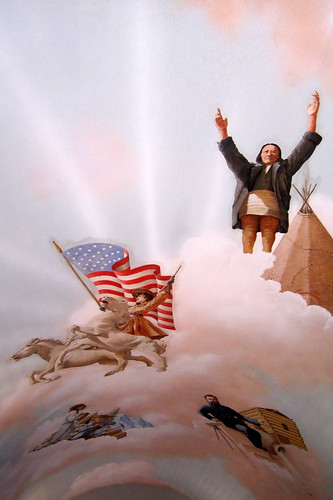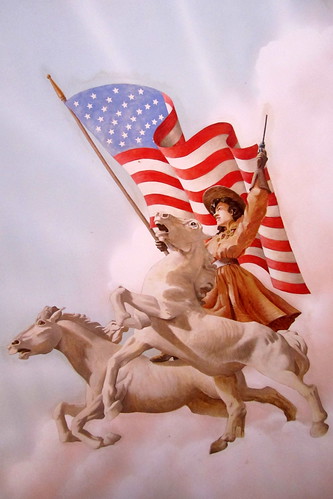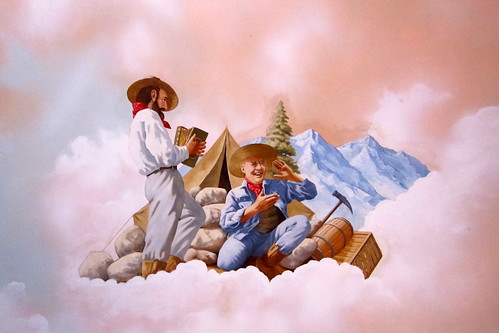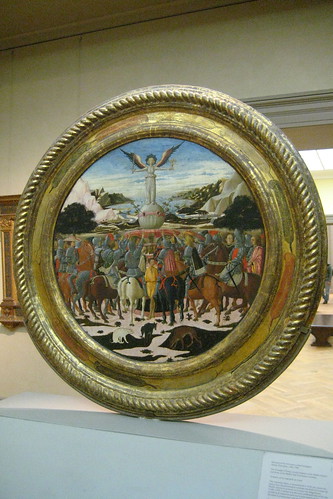Denver - LoDo: Larimer Square - Kettle Arcade ceiling
Image by wallyg
The ceiling along the Kettle Arcade, leading out from the Kettle Building, features paintings of some old west celebrities who frequented Larimer Street including Chief Hosa (Little Raven), chief of the Native American Arapahoe tribe who learned to communicate with the white man to promote peace; Annie Oakley, a famous markswoman who made her name traveling the world with Buffalo Bill’s Wild West Show; Denver’s founder, General William H. Larimer; Soapy Smith and Robert Speer, the king of Western Con Men and Denver's first mayor, respectively.
The Larimer Square Historic District, covering the 1400 block of Larimer Street, was the birthplace of Denver City in 1858, with false-fronted stores, hotels and saloons catering to prospectors and pioneers. The original wood buildings were destroyed during the fires of 1863, but the surviving second generation two and three-story late Victorian brick buildings date from the late 19th century. In the mid 1870's, it was the main street of the city, and the site of Denver's first post office, bank, theater, and streetcar line. By the 1930s, urban decay left a skid row of pawnshops, gin mills, and flophouses. The buildings were spared demolition from the sweeping urban renewal projects of the mid-1960's, primarily due to the efforts of Denver preservationist Dana Crawford. As part of the nation's first historic neighborhood revitalization campaign, a for-profit corporation renovated all 16 of the block's commercial buildings in 1969, providing mixed space for shops, restaurants and offices.
Larimer Square Historic District National Register #73000468 (1973)
Denver - LoDo: Larimer Square - Kettle Arcade ceiling - Annie Oakley
Image by wallyg
The ceiling along the Kettle Arcade, leading out from the Kettle Building, features paintings of some old west celebrities who frequented Larimer Street including Chief Hosa (Little Raven), chief of the Native American Arapahoe tribe who learned to communicate with the white man to promote peace; Annie Oakley, a famous markswoman who made her name traveling the world with Buffalo Bill’s Wild West Show; Denver’s founder, General William H. Larimer; Soapy Smith and Robert Speer, the king of Western Con Men and Denver's first mayor, respectively.
The Larimer Square Historic District, covering the 1400 block of Larimer Street, was the birthplace of Denver City in 1858, with false-fronted stores, hotels and saloons catering to prospectors and pioneers. The original wood buildings were destroyed during the fires of 1863, but the surviving second generation two and three-story late Victorian brick buildings date from the late 19th century. In the mid 1870's, it was the main street of the city, and the site of Denver's first post office, bank, theater, and streetcar line. By the 1930s, urban decay left a skid row of pawnshops, gin mills, and flophouses. The buildings were spared demolition from the sweeping urban renewal projects of the mid-1960's, primarily due to the efforts of Denver preservationist Dana Crawford. As part of the nation's first historic neighborhood revitalization campaign, a for-profit corporation renovated all 16 of the block's commercial buildings in 1969, providing mixed space for shops, restaurants and offices.
Larimer Square Historic District National Register #73000468 (1973)
Denver - LoDo: Larimer Square - Kettle Arcade ceiling - Soapy Smith and Mayor Speer
Image by wallyg
The ceiling along the Kettle Arcade, leading out from the Kettle Building, features paintings of some old west celebrities who frequented Larimer Street including Chief Hosa (Little Raven), chief of the Native American Arapahoe tribe who learned to communicate with the white man to promote peace; Annie Oakley, a famous markswoman who made her name traveling the world with Buffalo Bill’s Wild West Show; Denver’s founder, General William H. Larimer; Soapy Smith, the king of Western con-men and Mayor Robert Speer.
The Larimer Square Historic District, covering the 1400 block of Larimer Street, was the birthplace of Denver City in 1858, with false-fronted stores, hotels and saloons catering to prospectors and pioneers. The original wood buildings were destroyed during the fires of 1863, but the surviving second generation two and three-story late Victorian brick buildings date from the late 19th century. In the mid 1870's, it was the main street of the city, and the site of Denver's first post office, bank, theater, and streetcar line. By the 1930s, urban decay left a skid row of pawnshops, gin mills, and flophouses. The buildings were spared demolition from the sweeping urban renewal projects of the mid-1960's, primarily due to the efforts of Denver preservationist Dana Crawford. As part of the nation's first historic neighborhood revitalization campaign, a for-profit corporation renovated all 16 of the block's commercial buildings in 1969, providing mixed space for shops, restaurants and offices.
Larimer Square Historic District National Register #73000468 (1973)
NYC - Metropolitan Museum of Art - Triumph of Fame
Image by wallyg
The Triumph of Fame; (verso) Impresa of the Medici Family and Arms of the Medici and Tornabuoni Families
birth tray, ca. 1449
Giovanni di Ser Giovanni (called Scheggia) (Italian, Florentine, 1406–1486)
Tempera, silver, and gold on wood; Overall, with engaged frame, diameter 36 1/2 in. (92.7 cm); recto, painted surface, diameter 24 5/8 in. (62.5 cm); verso, painted surface, diameter 29 5/8 in. (75.2 cm)
This imposing object, a commemorative birth tray (desco da parto), was commissioned to celebrate the birth of Lorenzo de' Medici, known to posterity as Lorenzo the Magnificent (1449–1492). Lorenzo was the most celebrated ruler of his day as well as an important poet and a major patron of the arts; his name is synonymous with the Renaissance.
The imagery is taken from Boccaccio's "L'Amorosa visione" as well as Petrarch's "Trionfi". Knights extend their hands in allegiance to an allegorical figure of Fame, who holds a sword and winged cupid (symbolic of celebrity through arms and love). Winged trumpets sound Fame's triumph. Captives are bound to the elaborate support. The three-colored ostrich feathers around the rim are a heraldic device of Lorenzo's father, Piero de' Medici.
Painted by the younger brother of Masaccio, this is an object of unique historical importance. It was kept by Lorenzo in his private quarters in the Medici palace in Florence and was acquired in the early years of the nineteenth century by Alexis-François Artaud de Montor, one of the earliest collectors of early Italian painting. Later it belonged to Thomas Jefferson Bryan, the first New Yorker to collect early Italian art.
The reverse of most surviving birth trays shows an image of a child. This one is decorated with the armorial device of Lorenzo the Magnificent's father, Piero de' Medici: a diamond ring with three ostrich feathers and a banderole with the motto SEMPER (forever). The device, now much worn and oxidized, may signify eternal faithfulness and strength. The Medici arms are in the upper left, those of the Tornabuoni are in the upper right. Piero de' Medici married Lucrezia Tornabuoni in 1444 and their first son, Lorenzo, was born in 1449.
The tradition of commissioning circular trays or salvers to commemorate a birth derived from the custom of presenting sweetmeats to the new mother. Painted for the most famous figure of the Italian Renaissance, this is the largest and most opulent birth tray known, and one of the few to survive with its original engaged molding.
Purchase in memory of Sir John Pope-Hennessy: Rogers Fund, The Annenberg Foundation, Drue Heinz Foundation, Annette de la Renta, Mr. and Mrs. Frank E. Richardson, and The Vincent Astor Foundation Gifts, Wrightsman and Gwynne Andrews Funds, special funds, and Gift of the children of Mrs. Harry Payne Whitney, Gift of Mr. and Mrs. Joshua Logan, and other gifts and bequests, by exchange, 1995 (1995.7)
**
The Metropolitan Museum of Art's permanent collection contains more than two million works of art from around the world. It opened its doors on February 20, 1872, housed in a building located at 681 Fifth Avenue in New York City. Under their guidance of John Taylor Johnston and George Palmer Putnam, the Met's holdings, initially consisting of a Roman stone sarcophagus and 174 mostly European paintings, quickly outgrew the available space. In 1873, occasioned by the Met's purchase of the Cesnola Collection of Cypriot antiquities, the museum decamped from Fifth Avenue and took up residence at the Douglas Mansion on West 14th Street. However, these new accommodations were temporary; after negotiations with the city of New York, the Met acquired land on the east side of Central Park, where it built its permanent home, a red-brick Gothic Revival stone "mausoleum" designed by American architects Calvert Vaux and Jacob Wrey Mold. As of 2006, the Met measures almost a quarter mile long and occupies more than two million square feet, more than 20 times the size of the original 1880 building.
In 2007, the Metropolitan Museum of Art was ranked #17 on the AIA 150 America's Favorite Architecture list.
The Metropolitan Museum of Art was designated a landmark by the New York City Landmarks Preservation Commission in 1967. The interior was designated in 1977.
National Historic Register #86003556
No comments:
Post a Comment